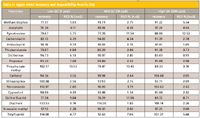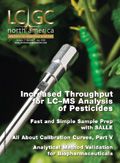Salting-out Liquid-Liquid Extraction (SALLE)
LCGC North America
Ron Majors discusses the technique of Salting-out Liquid-Liquid Extraction (SALLE) and provides some examples of its successful applications.
Liquid–liquid extraction (LLE), also known as solvent extraction, has long been an effective method of separating compounds having different solubilities in two immiscible liquids (1). The two liquids are typically water, perhaps with some additives, and a nonpolar organic solvent such as isooctane. Typically, polar compounds prefer the aqueous layer while nonpolar compounds are extracted into the organic layer. A drawback of the use of nonpolar, water-immiscible organic solvents is that due to their low dielectric constants, they are relatively poor at the extraction of very polar or highly charged solutes, particularly for highly water-soluble pharmaceuticals that may require extractions at very low or very high pH values. More-polar solvents (such as acetonitrile) that provide solubility for these more-polar compounds are frequently water-miscible and, thus, cannot be used for conventional LLE.

Ronald E. Majors
It has long been known that the addition of an inorganic salt into a mixture of water and a water-miscible organic solvent causes a separation of the solvent from the mixture and the formation of a two-phase system (2). Sometimes this phenomenon is referred to as "salt-induced phase separation." Observations of this "salting-out" phenomenon were made for a number of water-miscible organics such as acetone, methanol, ethanol, and acetonitrile. Different salts and different salt concentrations will cause different degrees of phase separation. The high-polarity, water-miscible solvents used in salting-out systems have been investigated for extraction or concentration of many analytes that cannot be extracted by conventional LLE methods. This salting out often occurs at high salt concentrations. In some cases, the "salting-out" (or perhaps better termed "sugaring out") effect also can be achieved with high concentrations of saccharides (3).
The purpose of this installment of "Sample Prep Perspectives" is to report on the use of salting-out extraction to isolate compounds of interest. Some pertinent applications will be cited. The extracts are not particularly clean relative to other, more intensive sample preparation procedures. This simple extraction process is useful especially when very selective detection is used in gas chromatography (GC) or high performance liquid chromatography (HPLC).
Background
Although the salting-out phenomenon has been known for many years, some systematic studies have been carried out to help choose the optimum solvent systems and salt additives. Matkovich and Christian (4) investigated the salting out of acetone from water as a solvent-extraction system for metal chelates. They were interested in finding a solvent system that would enhance the sensitivity of flame emission and atomic absorption spectrometry measurements for metal ions. By extraction of the metals as their chelates into the acetone phase in the absence of water, sensitivity could be enhanced. Their investigations included 79 salting-out agents, and of those found for this water–acetone system, calcium chloride, magnesium chloride, and sucrose were most effective.
Salting out extraction has been used for the preconcentration of neutral polar organics from water. Leggett and coworkers showed that high recoveries of trace explosive compounds can be achieved from water using acetonitrile–sodium chloride salting-out extraction (5). They initially used conventional LLE with methylene chloride as an extraction solvent and, as reported in Table I, for some nitroamines such as HMX and RDX, extraction efficiency was rather poor. Addition of sodium chloride to the water improved the situation a bit but the salting-out extraction with acetonitrile gave the greatest overall recoveries. In fact, the U.S. Environmental Protection Agency method 8330A for the isolation of nitroaromatic and nitramine explosives from water at the nanogram-per-liter level is based upon a salting-out extraction method (6). The method involves the addition of 251 g of sodium chloride to a 1-L volumetric flask containing 770 mL of water sample. The addition of 164 mL of acetonitrile with stirring is followed by a phase separation step. Removal of the acetonitrile upper layer is followed by some additional small volume extractions and a back extraction. Finally, an aliquot is injected into a reversed-phase HPLC column with a further confirmation on a cyano column.

Table I: Recoveries of nitroaromatics, nitramines, and nitrate esters from water by salting-out extraction (%)*
Extractions using the salting-out effect began to be used more extensively in the area of pesticide analysis. First, nonionic pesticides in various vegetable food samples were extracted using water-miscible organic solvents like acetonitrile and methanol. The Luke method showed that acetone–water (65:35, v/v) also could be used for this purpose (7). A multiclass, multiresidue method (MRM) was used by Mills and coworkers to extract nonpolar pesticides from various food samples of vegetal origin using acetonitrile (8). The addition of sodium chloride and water to the acetonitrile extract allowed partitioning into a very nonpolar solvent, petroleum ether. The use of acetonitrile followed by salting out proved to be better suited for the extraction of both nonpolar and polar pesticides from vegetable samples and has been adopted today by several regulatory bodies (9). However, the extracts were still rather "dirty."
In 1993, Anastassiades, Lehotay, and coworkers from the U.S. Department of Agriculture in Wyndmoor, Pennsylvania (10) further refined the acetonitrile extraction by using sodium chloride salting out plus the addition of a drying agent (magnesium sulfate) to remove the water and force the pesticides into the acetonitrile phase. Termed the QuEChERS technique, pronounced "catchers," standing for quick, easy, cheap, effective, rugged, and safe, the technique has caught on quickly (11). Following the acetonitrile extraction step, the introduction of a dispersive solid-phase extraction (SPE) step in which a portion of the raw extract is mixed with bulk SPE sorbent such as C18, primary-secondary amine, and graphitized carbon helps to further clarify the extract and, after centrifugation, allows the supernatant to be injected directly into a GC–mass spectrometry (MS) or LC–MS or LC–MS-MS system. Hundreds of pesticide residues in a wide variety of fruits and vegetables are now done routinely using QuEChERS cleanup. Official regulatory methods are now available (12).
Other Uses of the Salting Out Effect
The salting-out effect also can be used to enhance extractions into nonpolar, immiscible organic solvents. For analytes that are extracted poorly with organic solvents commonly employed in routine work (for example, diethyl ether), salting out may enhance the extraction efficiency of various organic compounds from aqueous solutions and, thus, improve sensitivity and precision of the analysis. Nicholic and coworkers (13) investigated salting-out extraction for the phenolic compounds catechol and hydroquinone in aqueous solution with diethyl ether and diisopropyl ether. They investigated ammonium, sodium, and potassium and magnesium chloride and sulfate salts. The magnesium salts were most effective owing to the high ionic potential of the Mg+ ion. Compared with a salt-free aqueous solution of catechol, when magnesium salts were present the extraction efficiency with diethyl ether increased by 14%. When hydroquinone with diisopropyl ether solvent with magnesium salts were present, extraction efficiency increased by 30%. Investigations of the phenols spiked into urine showed similar increases, indicating that the extraction could be used for real samples.
Salting out also has been used effectively with vapor-phase extraction using headspace techniques. The addition of an inorganic salt often has been used to enhance the activity coefficients of volatile components in aqueous solutions, increasing the concentration in the headspace vapor. The salts also are applied to equalize the activity coefficients of analytes in different matrices (water, whole blood, serum, plasma, urine, and saliva). The salting-out effect depends upon the analyte and type of salt used. The higher the number of carbon atoms in a compound, the greater the effect of salting out. Salting out results in the lower solubility of high molecular weight compounds in water. In most cases, an increase in salt concentration results in a higher concentration of analytes in the headspace. One study found that the most effective salts were potassium carbonate, ammonium sulfate, and sodium citrate (dehydrate) (14). The use of high concentrations of sodium sulfate added to wine were found to increase the level of aroma compounds in solid-phase microextraction (SPME) headspace experiments (15). In this work, sodium sulfate was selected because of its high solubility in aqueous solutions and due to the production of triple-molar amounts of ions upon dissociation. These factors combine to yield high ion levels in the wine, enhancing the effects of salting out. A saturation level of 2.1 g Na2SO4 per 6.0 mL aqueous sample was found to be optimal. The salting-out effect also can aid the adsorption of hydrophobic organic compounds from aqueous solution onto SPME fibers or SPE cartridges.
Applications Examples of Salting Out Extraction
Drugs in biological fluids: The salting-out extraction technique also can be used for the extraction of drugs from biological fluids. Recently, Zhang and coworkers (16) investigated salting-out assisted LLE with acetonitrile for the drug Kaletra (Abbott Laboratories, Abbott Park, Illinois) in human and animal plasma samples. Two compounds (lopinavir and ritonavir) are formulated in Kaletra, which is used as an inhibitor of the HIV-1 protease. The authors performed the experiments in 96-well plates using an automated liquid handling system. Using this system and acetonitrile–magnesium sulfate salting out, an entire validation was performed in less than a day using reversed-phase HPLC with tandem MS detection for the analysis of extracts. For extraction, less than 100 μL of spiked plasma was used and only 200 μL of acetonitrile and 50 μL of 2 M magnesium sulfate were required for each well. Centrifugation was used to aid in phase separation. The total extraction efficiency was 62–84% across lots, species, and concentration levels. The % CV was 2.7–6.5% for lopinavir and 3.3–6.5% for ritonair, very acceptable values. Another publication from the same group used an MS-friendly organic salt, ammonium acetate, as a salting-out reagent with acetonitrile for a hydrophobic drug candidate and its metabolite in human plasma (17).
Pesticides in fruits and vegetables: Salting out extraction has gained popularity because it is included in the initial step of the often-used QuEChERS method for the multiclass, multiresidue analysis of pesticides in fruits, vegetables, and other foods. Although sodium chloride was used for salting out in the original QuEChERS method (10), refinements were made when it was discovered that some base-sensitive compounds such as the fungicides chlorothalonil and captan gave poor recovery. The new method is buffered with 1% acetic acid and sodium acetate instead of sodium chloride (18) and forms the basis for the American Association of Analytical Chemists (AOAC) QuEChERS method (12). To illustrate the application of this technique, I will show some results obtained for the extraction and analysis of 16 "representative" pesticides in apples (19). The representative list chosen by Lehotay and coworkers (18) included nine pesticide classes, including acidic, basic, neutral, base-sensitive, and acid-labile pesticides suitable for LC–MS-MS analysis.
To get the most reliable statistical results, the sample preparation is an extremely important part of the QuEChERS process. A large enough sample must be used in order to obtain a representative portion and this large sample must be comminuted finely as only 15 g is required for the QuEChERS extraction. A 15 g sample of comminuted apple (from 3 lb of organically grown apples) was placed into a 50-mL centrifuged tube and an internal standard was added followed by vortexing. Next, 15 mL of 1% acetic acid in acetonitrile was added followed by an Agilent AOAC Buffered Extraction packet (Agilent, Santa Clara, California) containing 6 g of anhydrous magnesium sulfate and 1.5 g of anhydrous sodium acetate. It is important to add the buffer salt after the addition of acetonitrile rather than directly to the raw sample. The addition of salt is an exothermic reaction and can cause localized heating in the sample potentially causing thermal decomposition. Next, the entire mixture was sealed tightly and shaken vigorously by hand followed by centrifugation. This operation represents the salting-out extraction step. Acetonitrile forms a separate upper layer from the water layer that results from the apple matrix itself.
The next step was a further clarification using dispersive SPE. A 1-mL aliquot of the upper acetonitrile layer was transferred into a 2-mL dispersive SPE tube containing preweighed 50 mg of primary secondary amine (PSA) and 150 mg of anhydrous magnesium sulfate. The tube was capped tightly, vortexed, and finally centrifuged. A 200-μL aliquot was transferred to an autosampler vial and diluted with 800 μL of water. The sample was then analyzed by LC–MS-MS. The flow chart of the entire process is depicted in Figure 1.

Figure 1
The HPLC separation was performed by gradient reversed-phase chromatography on a phenyl-hexyl column. The conditions are given in Figure 2. The LC–MS-MS chromatograms of an apple blank carried through the entire QuEChERS procedure is shown in Figure 2a. The final QuEChERS-prepared sample may contain food matrix impurities because it is a very simple sample extraction and cleanup procedure. With the powerful selectivity of LC–MS-MS operated in the multiple reaction monitoring (MRM) mode (see instrument data acquisition settings in reference 19), the extract apple blank did not contribute any interferences with the target compounds. Figure 2b shows the chromatogram of a 5-ng/g (5-ppb) fortified apple extract at the limit of quantitation (LOQ). This LOQ for the pesticides in apple shown was well below the maximum residue levels (MRLs). Even though some of the pesticide peaks showed poor chromatographic resolution, the selectivity of electrospray ionization tandem MS permitted the accurate quantitation. Mean recoveries ranged between 76% and 117% (95.4% on average) with RSD values below 15% (4.3% on average). Table II provides recovery and reproducibility data over the concentration range investigated (19) for n = 6 replicates.

Figure 2
Heavy metal ions in aqueous solution: When adding inorganic salts to acetonitrile–aqueous solutions, phase separation occurs with consequent extraction of metal complexes into the acetonitrile-rich phase. The main drawback when extracting and measuring trace metals as their complexes is that impurities that might be present in the inorganic salt are extracted into the acetonitrile phase as well. Nagaosa and coworkers (20) proposed the use of a hydrophobic organic salt instead. They chose tetrabutylammonium perchlorate (TBAP) as a phase-separating agent in order to avoid the presence of trace metallic impurities. They showed that neutral metal chelates can be extracted and preconcentrated into the acetonitrile-rich phase. The authors were able to determine copper(II) and nickel(II) in biological samples (tea and citrus leaves) by reversed-phase HPLC analysis following acetonitrile extraction of their dibenzyldithiocarbamate (DBDTC) chelates.

Table II: Apple AOAC Recovery and Repeatibility Results (19)
In their case, the samples were digested using nitric acid–sulfuric acid–perchloric acid (2:1:1), then adjusted to pH 2 with sodium hydroxide and diluted with water. A 5.0-mL volume of 20 mM DBDTC solution in acetonitrile and 2 mM TBAP as the phase separation agent were added to a 5.0-mL volume of this sample solution. After vigorous shaking for 1.0 min, the acetonitrile phase was separated and a 100-μL aliquot was injected onto a C18 column using a 4:1 (v/v) acetonitrile–20 mM acetate buffer (pH 4.4) containing 0.01 M potassium nitrate mobile phase. The flow rate was 1.0 mL/min and detection was at 254 nm. Chromatograms resulting from the analysis of tea leaves and citrus leaves showed that the excess TBAP eluted well award from the metal complexes so did not pose a problem. The detection limits (signal/noise of 2) were found to be 1.0 ng/mL for Ni (II) and 2.0 ng/mL for Cu (II). Linearity and correlation coefficents were found to be excellent for both metal complexes.
Conclusion
The salt-induced phase separation of water-miscible organic solvents in aqueous solution has been used successfully for partitioning polar analytes into the organic phase. Acetonitrile appears to be the most frequently used extractant, and sodium chloride and magnesium sulfate are the most frequently used salts. However, other inorganic salts, saccharides, and organic salts and other organic solvents have been used. The fastest growing area for salting-out extraction is for the QuEChERS technique for multiclass, multiresidue pesticide analysis of fruits and vegetables.
The salting-out extraction technique is simple, fast, and results in extracts that are in an organic solvent that can be evaporated and reconstituted into a suitable solvent for HPLC or GC analysis. Compared to more elaborate sample preparation techniques, the extracts are not as "clean," but the use of selective detection, especially tandem MS, often allows the direct analysis of extracts without further treatment. It also has been used in capillary electrophoresis but these results were not reported here.
Ronald E. Majors "Sample Prep Perspectives" Editor Ronald E. Majors is business development manager, Consumables and Accessories Business Unit, Agilent Technologies, Wilmington, Delaware, and is a member of LCGC's editorial advisory board. Direct correspondence about this column to "Sample Prep Perspectives," LCGC, Woodbridge Corporate Plaza, 485 Route 1 South, Building F, First Floor, Iselin, NJ 08830, e-mail lcgcedit@lcgcmag.com.
References
(1) R.E. Majors, LCGC 26(12), 1158–1166 (2008).
(2) G.B. Frankforter and L. Cohen, J. Am. Chem. Soc. 36, 1103–1134 (1914).
(3) B. Wang, T. Ezeji, H. Feng, and H. Blaschek, Chem. Eng. Journal 63, 2595–2600 (2008).
(4) C.E. Matkovich and G.D. Christian, Anal. Chem. 45(11), 1915–1921 (1973).
(5) D.C. Leggett, T.F. Jenkins, and P.H. Miyares, Anal. Chem. 62, 1355–1356 (1990).
(6) Method 8330A Nitroaromatics and Nitramines by High Performance Liquid Chromatography,Rev.1, U.S. Environmental Protection Agency, January 1998.
(7) M.A. Luke and G.M. Doose, Bull.Environ. Contam. 30, 110 (1983).
(8) P.A. Mills, J.H. Onley, and R.A. Gaither, J. Assoc. Off. Anal. Chem. 46, 186 (1963).
(9) F.J. Schenck and J.W. Wong in Analysis of Pesticides in Food and Environmental Samples, J.L. Tadeo, Ed. (CRC Press, Boca Raton, 2008), p.154.
(10) M. Anastassiades, S.J. Lehotay, D. Stainbaher, and F. Schenk, J. AOAC Int. 86, 412–431 (2003).
(11) R.E. Majors, LCGC 25(5), 436–446 (2007).
(12) AOAC Official 2001.01 Method: Pesticide Residues in Foods by Acetonitrile Extraction and Partitioning with Magnesium Sulfate.
(13) G.M. Nikolic, J.M. Perovic, R.S. Nikolic, and M.M. Cakic, Physics, Chemistry, and Technology 2(5), 293–299 (2003).
(14) B.V. Ioffe and A.G. Vitenberg, Headspace Analysis and Related Methods in Gas Chromatography (Wiley-Interscience, New York, 1983).
(15) http://www.asev.org/docs05BestPaperAward-Enology.pdf
(16) J. Zhang, H. Wu, E. Kim, and T.A. El-Shourbagy, Biomed. Chromatogr. 23, 419–425 (2009).
(17) H. Wu, J. Zhang, K. Norem, and T. El-Shourbagy, J. Pharm. Biomed. Anal. 48, 1243–1248 (2008).
(18) S.J. Lehotay, K. Mastovska, and A.R. Lightfield, J. AOAC Int. 88, 630–638 (2005).
(19) L. Zhao, D. Schulz, and J. Stevens, "Analysis of Pesticide Residues in Apples using Agilent SampliQ QuEChERS Kit by LC-MS/MS Detection", Agilent Technologies, Wilmington, Delaware, Application Note 5990-3937EN, 2009.
(20) Y. Nagosa, M. Taniguchi, and J. Miura, "Hydrophobic salt-induced phase-separation and extraction for sample preparation in chromatographic determination of heavy metal ions as dibenzyldithiocarbamates", Anal. Chemica Acta, 356, 135-140 (1997).

Thermodynamic Insights into Organic Solvent Extraction for Chemical Analysis of Medical Devices
April 16th 2025A new study, published by a researcher from Chemical Characterization Solutions in Minnesota, explored a new approach for sample preparation for the chemical characterization of medical devices.
Study Explores Thin-Film Extraction of Biogenic Amines via HPLC-MS/MS
March 27th 2025Scientists from Tabriz University and the University of Tabriz explored cellulose acetate-UiO-66-COOH as an affordable coating sorbent for thin film extraction of biogenic amines from cheese and alcohol-free beverages using HPLC-MS/MS.

.png&w=3840&q=75)

.png&w=3840&q=75)



.png&w=3840&q=75)



.png&w=3840&q=75)






